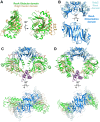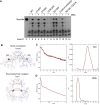The crystal structure of bacteriophage λ RexA provides novel insights into the DNA binding properties of Rex-like phage exclusion proteins
- PMID: 38554102
- PMCID: PMC11077077
- DOI: 10.1093/nar/gkae212
The crystal structure of bacteriophage λ RexA provides novel insights into the DNA binding properties of Rex-like phage exclusion proteins
Abstract
RexA and RexB function as an exclusion system that prevents bacteriophage T4rII mutants from growing on Escherichia coli λ phage lysogens. Recent data established that RexA is a non-specific DNA binding protein that can act independently of RexB to bias the λ bistable switch toward the lytic state, preventing conversion back to lysogeny. The molecular interactions underlying these activities are unknown, owing in part to a dearth of structural information. Here, we present the 2.05-Å crystal structure of the λ RexA dimer, which reveals a two-domain architecture with unexpected structural homology to the recombination-associated protein RdgC. Modelling suggests that our structure adopts a closed conformation and would require significant domain rearrangements to facilitate DNA binding. Mutagenesis coupled with electromobility shift assays, limited proteolysis, and double electron-electron spin resonance spectroscopy support a DNA-dependent conformational change. In vivo phenotypes of RexA mutants suggest that DNA binding is not a strict requirement for phage exclusion but may directly contribute to modulation of the bistable switch. We further demonstrate that RexA homologs from other temperate phages also dimerize and bind DNA in vitro. Collectively, these findings advance our mechanistic understanding of Rex functions and provide new evolutionary insights into different aspects of phage biology.
© The Author(s) 2024. Published by Oxford University Press on behalf of Nucleic Acids Research.
Figures








Similar articles
-
Polarity within pM and pE promoted phage lambda cI-rexA-rexB transcription and its suppression.Can J Microbiol. 2005 Jan;51(1):37-49. doi: 10.1139/w04-115. Can J Microbiol. 2005. PMID: 15782233
-
Over-expression of rexA nullifies T4rII exclusion in Escherichia coli K(lambda) lysogens.Can J Microbiol. 2004 Feb;50(2):133-6. doi: 10.1139/w03-115. Can J Microbiol. 2004. PMID: 15052316
-
Bacteriophage λ RexA and RexB functions assist the transition from lysogeny to lytic growth.Mol Microbiol. 2021 Oct;116(4):1044-1063. doi: 10.1111/mmi.14792. Epub 2021 Aug 30. Mol Microbiol. 2021. PMID: 34379857 Free PMC article.
-
A snapshot of the λ T4rII exclusion (Rex) phenotype in Escherichia coli.Curr Genet. 2021 Oct;67(5):739-745. doi: 10.1007/s00294-021-01183-2. Epub 2021 Apr 20. Curr Genet. 2021. PMID: 33877398 Review.
-
Yet another way that phage λ manipulates its Escherichia coli host: λrexB is involved in the lysogenic-lytic switch.Mol Microbiol. 2015 May;96(4):689-93. doi: 10.1111/mmi.12969. Epub 2015 Mar 16. Mol Microbiol. 2015. PMID: 25684601 Review.
Cited by
-
CRISPRi-ART enables functional genomics of diverse bacteriophages using RNA-binding dCas13d.Nat Microbiol. 2025 Mar;10(3):694-709. doi: 10.1038/s41564-025-01935-7. Epub 2025 Feb 26. Nat Microbiol. 2025. PMID: 40011704 Free PMC article.
-
The change of long tail fibers expanded the host range of a T5-like Salmonella phage and its application in milk.BMC Microbiol. 2025 Mar 26;25(1):169. doi: 10.1186/s12866-025-03895-8. BMC Microbiol. 2025. PMID: 40133802 Free PMC article.
-
Lambdoid phages with abundant Chi recombination hotspots reflect diverse viral strategies for recombination-dependent growth.Genome Res. 2025 Aug 1;35(8):1767-1780. doi: 10.1101/gr.280248.124. Genome Res. 2025. PMID: 40639916 Free PMC article.
References
-
- Lederberg E. Lysogenicity in E. coli K12. Genetics. 1951; 36:560.
-
- Dodd I.B., Shearwin K.E., Egan J.B.. Revisited gene regulation in bacteriophage λ. Curr. Opin. Genet. Dev. 2005; 15:145–152. - PubMed
Publication types
MeSH terms
Substances
Grants and funding
LinkOut - more resources
Full Text Sources

